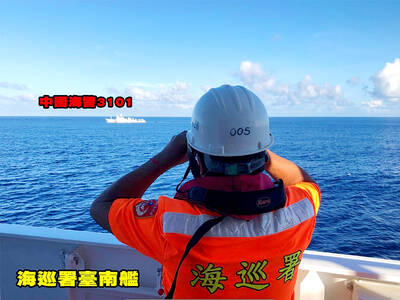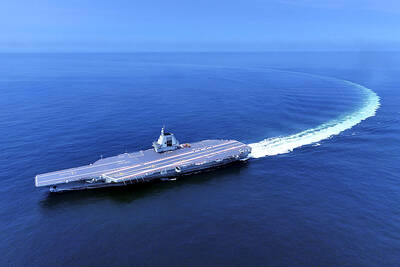China’s oceanographic survey and research ships are collecting data in the Indo-Pacific region, possibly to better navigate the area with submarines, detect undersea cables or lay undersea mines, a New York Times article published yesterday said.
The article was titled “China Surveys Seabeds Where Naval Rivals May One Day Clash.”
Starboard Maritime Intelligence data revealed that Chinese research ships last year repeatedly scanned the ocean floor east of Taiwan’s maritime border and about 400km east and west of Guam; “waters that China’s navy considers strategically vital,” the article said.

Photo: CNA
Last year, six research ships made 25 passes in parallel lines through the waters off Taiwan’s east coast, the article said.
Ships frequently navigated close to Taiwan’s 12 nautical mile (22km) territorial sea boundary, but never crossed it, leaving Taipei unable to protest, it added.
Moreover, they moved in parallel lines and grid formations, “precise patterns that experts said suggested a methodical effort to collect information about the seabed,” it said.
The majority of China’s research ships are civilian, run by government agencies, universities and institutes, which attract less attention and scrutiny than naval vessels, the article said.
Under international law, civilian research ships are able to navigate through international waters and other countries’ exclusive economic zones with permission, it said.
However, Ocean Affairs Council Minister Kuan Bi-ling (管碧玲) said: “it’s hard for us to view this situation as normal.”
The article noted the alarming scale of China’s operations, with the Xiang Yang Hong No. 6 (向陽紅06) having surveyed the seabed surrounding Guam over an area larger than the UK.
“The tracks are so tightly packed, and all this was done in one year. Clearly, they were doing a bathymetric survey,” said Sen Jan (詹森), a professor of oceanography at National Taiwan University.
Bathymetric surveys map the seabed using technology such as sonar.
The article suggested alternative uses for the voyages, including mineral exploration, studying marine life and assessing the impact of climate change, though it added that “the growing research fleet could give Beijing a powerful advantage in maritime competition with the United States.”
These research activities only “pave the way for submarine operations,” said Jennifer Parker, a former Australian naval officer who is now an expert associate at the National Security College of Australian National University.
Chinese experts in 2010 said that understanding the Kuroshio Current northeast of Taiwan would help China “better conceal ourselves and attack our enemies,” the article added.
The suspicious activities continue, it said, adding that just last month, the Xiang Yang Hong No. 1 (向陽紅01) and Xiang Yang Hong No.5 (向陽紅五號05) were observed moving in grid-like patterns to the east of Guam.

The Coast Guard Administration (CGA) yesterday said it had deployed patrol vessels to expel a China Coast Guard ship and a Chinese fishing boat near Pratas Island (Dongsha Island, 東沙群島) in the South China Sea. The China Coast Guard vessel was 28 nautical miles (52km) northeast of Pratas at 6:15am on Thursday, approaching the island’s restricted waters, which extend 24 nautical miles from its shoreline, the CGA’s Dongsha-Nansha Branch said in a statement. The Tainan, a 2,000-tonne cutter, was deployed by the CGA to shadow the Chinese ship, which left the area at 2:39pm on Friday, the statement said. At 6:31pm on Friday,

The Chinese People’s Liberation Army Navy’s (PLAN) third aircraft carrier, the Fujian, would pose a steep challenge to Taiwan’s ability to defend itself against a full-scale invasion, a defense expert said yesterday. Institute of National Defense and Security Research analyst Chieh Chung (揭仲) made the comment hours after the PLAN confirmed the carrier recently passed through the Taiwan Strait to conduct “scientific research tests and training missions” in the South China Sea. China has two carriers in operation — the Liaoning and the Shandong — with the Fujian undergoing sea trials. Although the PLAN needs time to train the Fujian’s air wing and

Taiwanese celebrities Hank Chen (陳漢典) and Lulu Huang (黃路梓茵) announced yesterday that they are planning to marry. Huang announced and posted photos of their engagement to her social media pages yesterday morning, joking that the pair were not just doing marketing for a new show, but “really getting married.” “We’ve decided to spend all of our future happy and hilarious moments together,” she wrote. The announcement, which was later confirmed by the talent agency they share, appeared to come as a surprise even to those around them, with veteran TV host Jacky Wu (吳宗憲) saying he was “totally taken aback” by the news. Huang,

The American Institute in Taiwan (AIT) put Taiwan in danger, Ma Ying-jeou Foundation director Hsiao Hsu-tsen (蕭旭岑) said yesterday, hours after the de facto US embassy said that Beijing had misinterpreted World War II-era documents to isolate Taiwan. The AIT’s comments harmed the Republic of China’s (ROC) national interests and contradicted a part of the “six assurances” stipulating that the US would not change its official position on Taiwan’s sovereignty, Hsiao said. The “six assurances,” which were given by then-US president Ronald Reagan to Taiwan in 1982, say that Washington would not set a date for ending arm sales to Taiwan, consult